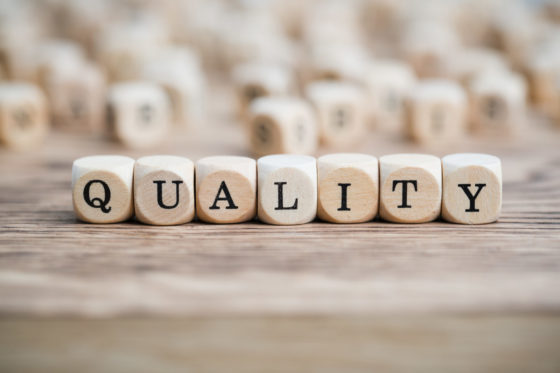
Measuring quality is a key step in quality control, but it’s also essential to assessing the entire translation system’s effectiveness. What’s more, it helps create a common language that links client expectations with how the translation provider operates. And these are just a few reasons why a well-thought out, tested quality framework is so important.
What makes up a successful quality framework
When properly understood, the data gleaned from a strong, sustainable quality framework allows managers to draw important conclusions, identify areas for optimization and present factual, accurate findings to clients. Here are the key parts that make up an effective translation quality framework.
Define the quality control of internal systems
When looking to control the quality and effectiveness of an internal translation system, the most important elements are:
- A thorough audit of processes, limitations, input/output, time constraints and resources (both human and technological)
- Realistic objectives
- An honest approach to interpreting numbers
- A plan for applying corrections
- A commitment to measuring the effect of such corrections
- An open mind when compromising the need for parameter consistency in adapting quality criteria to the individual needs of each client
Align with the client’s quality expectations
A quality framework creates a common language for aligning quality measurements with client expectations through:
- An understanding of what quality means for the client
- A model that is developed with the client’s concerns, needs and budget in mind
- An analysis of source texts
- The creation of appropriate criteria, requirements and guidelines for different types of content (like technical versus marketing content)
- A recurring measurement loop that goes through a few instances of client feedback to ensure expectations from all parties line up
- The continuous update/correction of reference material and instructions
Connect how budget relates to translation quality
Like any piece of writing, a translation is most successful when reviewed by a second pair of eyes, meaning a proofreader or editor. This applies to both human and machine translations, and ensures the quality that clients expect. There are also extra layers of review, like linguistic testing or in-country linguistic review, that go above and beyond basic proofreading. These added human hours typically require additional fees to further assess and optimize content for its defined purpose.
Manage expectations & define the task
In an ideal world, translation providers assign the most knowledgeable, specialized and experienced human resources to each task. However, the real world doesn’t always work this way. What happens if, for example, their rates don’t fit the outlined budget? And what if they simply aren’t available during the timeline needed?
An effective strategy is to provide experienced linguists, who have subject matter expertise in the desired field, with detailed instructions, examples and context upfront so they can understand and meet client expectations. Properly defining the task and briefing the linguist from the start can significantly improve quality (and reduce time spent editing).
Ask important questions about operational effectiveness
Finally, and this is valid for both points mentioned above, it’s important to answer a couple of questions:
- Did implementing a quality framework bring about adequate quality improvements?
- Is the impact on time and resources proportional to the effort?
When to measure quality and gather data
At Acclaro, we assess quality in two separate phases: first during the editing stage, and then again before final delivery to the client.
Measuring quality at the editing stage
At this stage, the editor logs every change they make to the translated text and classifies the correction according to a model that we have studied and implemented. This feedback is often directly integrated into the provider’s computer-assisted translations (CAT) software of choice.
Each error category marks different points or penalties across a variety of categories, like grammar, punctuation, context and style. So, once the editor logs the errors, the text receives a score and a pass/fail mark. The linguist can see all the errors and follow how the editor classified them. At the same time, managers can create a report with a summary of all findings. Collecting and analyzing the data contained in these reports is important to ensuring a healthy quality framework.
We use these reports for a few different purposes:
- Evaluating the output of each linguist assigned to the project
- Confirming the validity of editing speed metrics
- Validating the used reference materials (were there too many non-defined terms in the glossary? Was the style guide detailed enough? Do we need to make instructions clearer to linguists?)
- Showing linguists what errors they made and giving them a chance to learn or respond, with the ultimate goal of them acknowledging the feedback and improving in subsequent assignments
Measuring quality before delivery
Sometimes, a third-party reviewer will perform a final check. When this is the case, the client requests this from the beginning. The reviewer usually belongs to the client’s company, but they may also belong to a completely separate entity.
Once any third-party review is complete, we measure the content according to various quality assessments before delivering it to the client. Internally, we use the data we collect from pre-delivery quality measurements to evaluate our entire process. These reports also act as a basis point for quality discussions with our clients.
How to measure quality accurately and sustainably
Now that we’ve discussed when to measure quality, let’s look at the question of how. The industry has developed some reference quality frameworks (like TAUS DQF or MQM), and they can all be used as a basis point for tailoring quality models to various needs. Of these, MQM (Multidimensional Quality Metrics) is the most common. And while MQM is very thorough, its complexity makes it a challenge to correctly, uniformly apply across all types of translation initiatives.
Choose a sustainable quality standard
For a quality framework to truly succeed, applying the same standards in exactly the same way to each translation program is key. In other words, the framework must be sustainable. This is why at Acclaro we’ve opted to create an effective, streamlined set of quality requirements that allow us to consistently and sustainably measure quality — each and every time. Our quality standards allow us to collect consistent, valuable data that we analyze and use to troubleshoot, improve processes and optimize our services.
Consistently collect and analyze the data
The quality framework compiles both quantitative and qualitative data. Once we’ve collected data at various stages of the quality measurement process, we present it in a way that allows managers to understand the practical takeaways.
Let’s look at the editing phase, for example. Here, data can highlight a linguist’s performance, glossary and style guide inadequacies, and project feasibility. And before delivery, the data gives a window into how smoothly the system worked. It can also help optimize processes and improve them for future initiatives.
Distinguish between system-related and quality-related problems
At Acclaro, we collect and analyze data to pinpoint areas of improvement. The data usually falls into two main categories: common causes and random incidents. Common causes relate to system inefficiencies, while random incidents refer to issues such as glossary problems or delayed translations. Being able to distinguish between the two enables us to fully understand the root cause of the problem and find the best solution.
Why a strong quality framework is so important
With a strong quality framework, the entire team has the information they need for efficient and accurate problem-solving. And when managers have the data to make informed decisions, the team can spot issues before they arise, foster collaborative relationships and continuously improve.
Addressing the root cause
For example, let’s imagine that a client is repeatedly dissatisfied with a translation. Without a firm quality framework, the project manager’s first reaction is usually to work with a different linguist who has a record of proven quality. But what was the root cause? Is the client’s style guide and glossary complete and accurate? Did the client detail their expectations and goals? With a quality framework in place, it’s much easier to establish the client’s expectations right from the get-go, and if problems arise, troubleshoot to identify the hitch.
Aiming for mutual understanding
Instead of battling client critique, we aim to foster mutual understanding and steer clear of non-descriptive feedback points like good, bad, unuseable and machine translated. Language professionals do indeed find it challenging to work with one-worded descriptions, especially since they often stem from preference. A key part in building healthy partnerships with clients is helping them channel their feedback by asking questions, like how the error has altered the original writer’s intent or could cause misunderstanding. While subjective opinions and different contexts can make discussions about quality a headache, a strong framework structures the conversation.
Fostering open dialogue
The data also opens up communication with clients regarding quality complaints. Using the example above, a quality framework allows the project manager to look at the data collected and see that the client’s reviewer gave input that makes it look like they would rather have seen a transcreation, which was not feasible per the client’s timeline.
Since there was a clearly-defined, transparent quality framework established with the client before beginning work, the project manager can go back to the client and lead a productive conversation that strengthens their partnership.
Sharing quality feedback
The benefits of feedback or data fully crystallize when shared with all parties involved in the translation effort. Everyone, from the program manager to the linguist to the editor, should know exactly what worked, what didn’t, and why. Communicating this information allows everyone to collectively work towards delivering high-end results.
Benefit from a sustainable, data-powered quality framework for ongoing success
Ultimately, a quality framework that can be applied to each translation initiative, no matter the scope, empowers both clients and translation providers. An approach that’s rooted in data helps to build trust, streamline processes and, ultimately, gives the client exactly what they need to successfully connect with their target language market.
When you partner with Acclaro, you can always expect a data-driven and consistent quality framework. Find out more about how we can deliver quality results for you today.
Insights for global growth

Power your strategic growth
Go beyond tactical localization with tailored, strategic solutions that resonate locally and drive growth globally.
Get started


